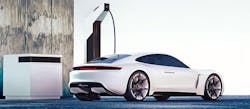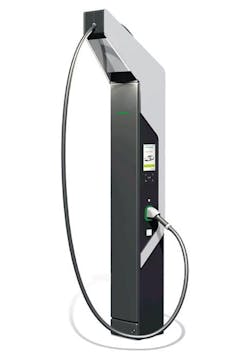Porsche’s Modular “Electric Pit Stop” Aims for Cost-Effective Fast Charging
At present, all components needed for quickly charging EVs are installed in each individual charging cabinet: transformer, galvanic isolation, power electronics, cooling, and connectivity—significant outlays that make each charging station disproportionately expensive.
Porsche Engineering has come up with what they believe is a viable alternative. Rather than load everything a charging station needs into a single cabinet, Porsche’s fast-charging EV solution employs modular building blocks that take into account the available electricity grid, visitor frequency, and space constraints.
Porsche engineers removed everything from the charging station that wasn’t absolutely required at the customer touchpoint. (Source: Porsche)
The system offloads some of the work traditionally done at the charging pole and packed it into “FlexBoxes.” These standardized, weatherproof housings, with exterior dimensions of 120 x 120 x 130 centimeters, can be positioned far from the customer (for example, behind a building).
A typical system includes a transformer, a PowerBox (to convert the transformer's ac power into dc) and a CoolingBox to liquid-cool multiple charging stations. The components are designed to accommodate a distance of up to 200 meters (656 feet) between the transformer station and PowerBox, and up to 100 meters between the PowerBox and the charging station. Technically, even greater distances are possible, albeit with higher power losses and, above all, higher construction costs.
The system is said to be able to charge the batteries of multiple electric cars at the same time. Thanks to 800-V technology (earlier this year, Porsche announced plans to deploy a network of 500 EV charging stations in North America to work with Taycan’s 800-V batteries), EVs can store enough energy for roughly 400 km of range in just 20 minutes—enough time for a coffee break at a rest stop or a few errands at the supermarket.
One technical advantage for medium-sized to large charging parks is the existence of a connection to the medium-voltage grid (up to 36 kV of ac). A transformer then converts this medium voltage into low voltage (local grid level). On the secondary side of the transformer, the same lower ac supply is always available irrespective of the location.
The transformer’s design also makes it possible to accommodate the galvanic isolation necessary for safety purposes. The centralized galvanic isolation obviates the need for it in each individual pole. Until now, it has been a part of the power electronics in all such poles, taking up space and driving up costs.
The system’s charge control unit automatically establishes communication with the vehicle. It compares the requirements of the vehicle with the capabilities of the charging station at the beginning of the charging procedure. If a vehicle is set up for the 800-V technology developed by Porsche, it can be charged at high power. However, the charging station from Porsche Engineering also supplies vehicles designed for lower charging power levels.
On top of that, the control unit handles communication with the back-end of the respective operator’s setup for payment purposes. As a result, according to Porsche Engineering, efficiency is boosted to over 95 % for the complete system, which means the possibility of significantly lower operating costs compared to systems available today.
The high-positioned, liquid-cooled charging cable can reach the charging socket of every electric vehicle. (Source: Porsche)
Technologically, Porsche employs the Combined Charging System (CCS1/CCS2) as the European standard. This is adapted to the higher voltage level and higher currents of the charging park. With small modifications to the charge control unit, it’s also possible to implement charging standards such as CHAdeMO or GB/T, enabling service to other vehicles even in regions as far afield as Japan and China.
How Does it Work, Exactly?
In operation, the low-voltage ac from the transformer station is converted into dc in the PowerBox. The PowerBox can be equipped with two sets of power electronics and supply two charging points. The system utilizes silicon-carbide (SiC) modules resulting in lower conduction and switching losses as well as reduced space requirements. Moreover, elements such as line filters can be built more compactly due to the higher pulse frequency.
Even for cases in which no sufficient powerful grid connection is available, the modular charging system offers a solution with which electric cars can be charged quickly. Specially designed for this purpose, the ChargeBox contains an additional buffer storage battery in addition to a power unit. This buffer battery is charged while no vehicle is using the charging station. With the storage battery as a replacement for grid power, the customer has access to high charging capacity at locations without medium-voltage grid connection.
The ChargeBox is well-suited for locations with a low charging frequency per day and situations in which an expansion of grid capacity would be expensive. The ChargeBox is available as an entry-level model with a 70-kWh battery and a 160-kW charging station.
For more highly frequented locations and for vehicles with higher charging capacities, there’s also a fully equipped version with 140 kWh and two 160-kW charging stations that can be combined for 320 kW. Another important element of the solution is provided by the smart-grid unit at the grid connection point, which ensures that the system never draws more than the permissible amount of electricity from the grid. This component also helps with the use of electricity from an existing PV system for fast charging and supports consumption optimization efforts through an energy-recovery mode at the location.
Another component of the charging park is the CoolingBox. The CoolingBox provides liquid cooling for the charging poles and power electronics. Every CoolingBox can accommodate two cooling units, each of which provides reliable cooling for multiple charging points under all operating conditions. On the exterior, a CoolingBox differs from the other FlexBoxes of the charging park system with its ventilation fins for intake and exhaust air. The CoolingBox is optimally positioned at some distance from the charging stations. This ensures that the unavoidable noises associated with cooling are kept far from customers’ ears.
If the operator works with just a few charging points, a compact alternative system is offered: The ComboBox combines the PowerBox and the CoolingBox—a power unit with a cooling unit sufficient for one charging point each.



